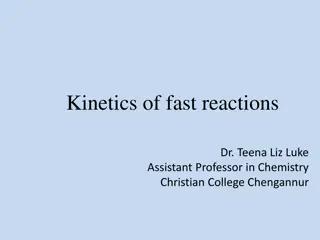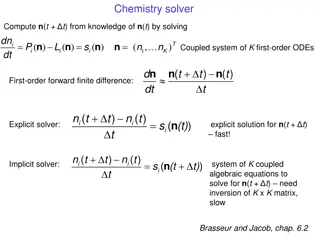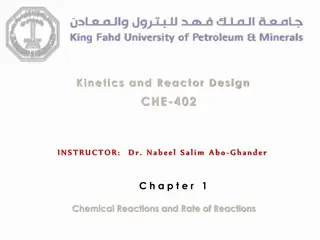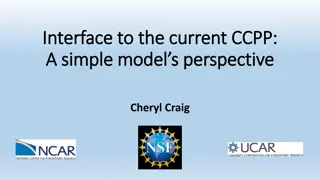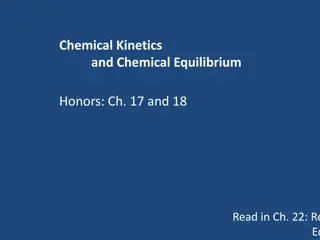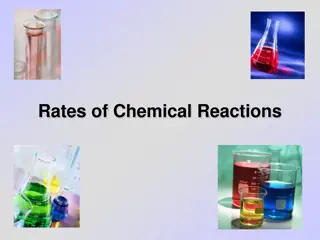Understanding Chemical Kinetics: Rates, Reactions, and Mechanisms
Chemical kinetics involves studying reaction rates, rate laws, stoichiometry, and factors affecting reaction speed. This branch of chemistry delves into determining reaction orders, rate constants, and activation energies using various methods. Different types of rates, such as initial, instantaneous, and average rates, provide insights into reaction progress over time. Through examples like the decomposition of nitrogen dioxide, the concept of average rates in reactions can be better understood.
Download Presentation

Please find below an Image/Link to download the presentation.
The content on the website is provided AS IS for your information and personal use only. It may not be sold, licensed, or shared on other websites without obtaining consent from the author. Download presentation by click this link. If you encounter any issues during the download, it is possible that the publisher has removed the file from their server.
E N D
Presentation Transcript
Chemical Kinetics Expression of rates. Stoichiometric relationships of rates of different substances in a reaction. Determination of reaction orders, rate laws, and rate constant by method of initial rate. Determination of rate laws by graphical or integration method. Determination of half-lives Determination of activation energy Elementary steps and reaction mechanism Effect of catalysts
Chemical Kinetics The study of reaction rates; How fast does a reaction proceeds and what factors affecting it; A measure of the change of the concentration of a reactant (or a product) as a function of time. The study of rate yields information on the mechanism by which a reaction occurs at molecular level.
Types of Rates Initial Rates Rates measured at the beginning of the reaction; Instantaneous Rates Rates measured at any point of time during the reaction; obtained from the slope of a line tangent to the curve at that point. Average Rates An overall rate measured over a period or time interval.
Instantaneous Rate: The decrease in Phenolphthalein Concentration
Average Rate Consider the following reaction at 300oC: 2 NO2(g) 2 NO(g) + O2(g) The initial concentration of NO2is 0.0100 mol/L and its concentration after 150 s is 0.0055 mol/L. What are the average rates for this reaction during the first and the second 150 s?
Average rate during the first 150 s Solution: Average rate = - [NO - ] 2 t - (0.0055 mol/L 0.0100 mol/L) = 150 s 0.0045 mol/L = 150 s = 3.0 x 10-5mol/(L.s)
Average rate during the second 150 s Solution: Average rate = - [NO - ] 2 t - (0.0038 mol/L 0.0055 mol/L) = 150 s 0.0017 mol/L = 150 s = 1.1 x 10-5 mol/(L.s) Average rate decreases as reaction progresses because the reactant concentration has decreased
Stoichiometric Relationships of Reaction Rates For a general reaction, aA + bB cC + dD, The stoichiometric relationships of the rates disappearance of reactants and rates of formation of products are as follows:
Expressions of Reaction Rates and Their Stoichiometric Relationships Consider the reaction: 2N2O5 4NO2 + O2 Rate of disappearance of N2O5 = [N O ] 2 5 t [ NO ] ] 2 Rate of formation of NO2 = t [O2 Rate of formation of O2= Stoichiometric relationships of these rates is: ( 4 t 2 t [N O ] [ NO ] [O ] 1 1 = = 2 5 2 2 ( ) ) t t
Differential Rate Law A mathematical expression that relates reaction rate to reactant concentrations at constant temperature. For example, for the reaction: aA + bB + cC Products Rate = k[A]x[B]y[C]z; k = rate constant; x, y&z = rate orders with respect to individual reactants; they are determined experimentally.
Rate Law For the decomposition of nitrogen dioxide: 2NO2(g) 2NO(g) + O2(g) Rate = k[NO2]n: k = rate constant n = the rate order with respect to [NO2 concentration; rate order is determined experimentally; Rate order indicates the degree in which the rate depends on the concentration of a particular reactant.
Rate Laws: A Summary Differential Rate Law only shows concentrations of reactants; We assume the reverse reaction has not occurred or is negligible. Integrated Rate Law shows how the concentration of a reactant is dependent on the time of reaction.
Types of Rate Laws Consider a general reaction: aA + bB Products The rate law is expressed as, Rate = k[A]x[B]y, Where the exponents x and y are called the rate order of the reaction w.r.t. the respective reactants; These exponents are usually small integers or simple fractions.
Types of Rate Laws 1. Zero-Order Reactions 1. In a zero order reaction the rate does not depend on the concentration of reactant, 2. For example, the decomposition of HI(g) on a gold catalyst is a zero-order reaction; 3. 2 HI(g) H2(g) + I2(g) 4. Rate = k[HI]0 = k; (The rate is independent on the concentration of HI)
Types of Rate Laws First Order Reactions In a first order reaction the rate is proportional to the concentration of one of the reactants. Example, for first-order reaction: 2N2O5(g) 4NO2(g) + O2(g) Rate = k[N2O5], The rate of decomposition of N2O5 is proportional to [N2O5], the molar concentration of N2O5
Types of Rate Laws Second Order Reactions In a second order reaction, the rate is proportional to the second power of the concentration of one of the reactants. Example, for the decomposition of NO2 follows second order w.r.t. [NO2] 2NO2(g) 2NO(g) + O2(g) Rate = k[NO2]2
Determination of Rate Law using Initial Rate Consider the following reaction: S2O82-(aq) + 3I-(aq) 2SO42-(aq) + I3-(aq)
Determination of Rate Law using Initial Rate Reaction: S2O82-(aq) + 3I- (aq) 2SO42- (aq) + I3- (aq) The following data were obtain. Expt. [S2O82-] [I-] # (mol/L) (mol/L) 1 0.036 0.060 2 0.072 0.060 3 0.036 0.120 Initial Rate, (mol/L.s) 1.5 x 10-5 2.9 x 10-5 2.9 x 10-5
Determination of Rate Law using Initial Rate Reaction: S2O82-(aq) + 3I-(aq) 2SO42-(aq) + I3-(aq) a) Determine the order of the reaction w.r.t. each reactant. Write the rate law for the above reaction. b) Calculate the rate constant, k, and give its appropriate units. c) Calculate the reaction rate when each reactant concentration is 0.20 M
Determination of Rate Law using Initial Rate Solution: The rate law = Rate = k[S2O82-]x[I-]y, here x and y are rate orders. (a) Calculation of rate order, x: ] O [S - 2 8 2 k - 2 8 x y - x y I [ x ] . 0 ( k 072 ) . 0 ( x 060 ) k M M = 2 = x 2 2 3 y y - . 0 ( k 036 ) . 0 ( 060 ) M M [S O ] [I ] 1 1 5 - 2.9 x 10 mol/L.s = 2 = = 1 = x 2 ~ y 5 - 1.5 x 10 mol/L.s
Determination of Rate Law using Initial Rate (b) Calculation of rate order, y: I [ ] O [S - 2 8 2 k - 2 8 y - x x y ] . 0 ( k 036 ) . 0 ( x 120 ) k M M = 2 = y 2 3 y y - . 0 ( k 036 ) . 0 ( 060 ) x M M [S O ] [I ] 1 5 - 2.9 x 10 mol/L.s = 2 = = 1 = y 2 ~ y 5 - 1.5 x 10 mol/L.s This reaction is first order w.r.t. [S2O82-] and [I-] Rate = k[S2O82-][I-]
Calculating rate constant and rate at different concentrations of reactants -5 1.5 x 10 mol/L Rate constant, k = (0.038 mol/L)(0.0 mol/L) 60 = 6.6 x 10-3 L.mol-1.s-1 If [S2O82-] = 0.20 M, [I-] = 0.20 M, and k = 6.6 x 10-3 L.mol-1.s-1 Rate = (6.6 x 10-3 L.mol-1.s-1)(0.20 mol/L)2 = 2.6 x 10-4 mol/(L.s)
Integrated Rate Law Graphical method to derive the rate law of a reaction: Consider a reaction with single reactant: R Products If the reaction is zero-order w.r.t. [R], Then, Rate t [R] - = = k
Integrated Rate Law for Zero-Order Reactions - [R] = = Rate k t [R] = -k t,and[R]t = [R]0 = kt; A plot of [R]tversus t yields a straight line with k = -slope.
Linear Plot for Zero-order Reactions Plot of [R]tversus t: slope = -k [R]t t
Integrated Rate Law for First Order If the reaction: R Products is a first order reaction, then - [R] = = [R] Rate k t [R] - = ln[R] = ln[R] t; - 0 t k k Which yields: t [R] And a plot of ln[R]tversus t will yield a straight line with slope = -k and y-intercept = ln[R]0
Linear Plot of First Order Reactions Plot of ln]R]tversus t: slope = -k ln[R]t t
Integrated Rate Law for Second Order If the reaction: R Products follows second- order kinetics, then or and [R] [R] 0 t [R] - [R] 1 = = = 2 [R] t Rate k k 2 t [R] 1 = k + t A plot of 1/[R]tversus t will yield a straight line with slope = k and y-intercept = 1/[R]0
Linear Plot for Second-order Reactions Plot of 1/[R]tversus time: 1 slope = k [ R] t time
Equations for Rate Laws w.r.t. [R]: Differential Rate Laws: 1. Zero order reaction: Rate = k; 2. First order reaction: Rate = k[R]; 3. Second order reaction: Rate = k[R]2; Integrated Rate Laws: 1. Zero order reaction: [R]t = kt + [R]0 2. First order reaction: ln[R]t = -kt + ln[R]0 1 1 Second order reaction: Rate = 3. = k + t [R] [R] t 0
Half-Lives of Reactions For zero-order reaction: t1/2 = [R]0/2k; For first-order reaction: t1/2 = 0.693/k; For second-order reaction: t1/2 = 1/(k[R]0) Note: For first-order reaction, the half-life is independent of the concentration of reactant, but for zero-order and second-order reactions, the half-lives are dependent on the initial concentrations of the reactants.
Exercise-#1 Consider the reaction aA Products. [A]0 = 5.0 M and k = 1.0 x 10 2 (assume the units are appropriate for each case). Calculate [A] after 30.0 seconds have passed, assuming the reaction is: a) Zero order b) First order c) Second order 4.7 M 3.7 M 2.0 M
A Model for Chemical Reactions For a reaction to occur: 1. Reactant molecules must collide with one another; 2. Molecular collisions must occur in a proper orientations to cause a reaction; 3. Collisions must produce sufficient energy to overcome the energy barrier, called the activation energy (Ea), and formthe transition-state complex; 4. The rate of formation of the transition-state complex is the rate determining step for the reaction.
The Collision Theory of Reactions All reactions are preceded by molecular collisions; Molecular collisions must be energetic and have proper orientation; Effective collision produces transition-state complex; The rate of transition-state complex formation is dependent on: the frequency of effective molecular collisions, which depends on concentrations, and temperature.
Orientation Factor in Collision Illustrated are two collisions that might take place between carbon monoxide and oxygen molecules. The orientation of the colliding molecules partially determines whether a reaction between the two molecules will occur.
Dependence of Rate on Temperature Reaction rates depend on the activation energy, Ea, and the temperature, T, such that: 1. Higher activation energy implies a high reaction barrier and a small fraction of reactant molecules will be able to form the transition-state complex, which results in a slower rate of reaction; 2. Increasing the reaction temperature results in a larger fraction of reactant molecules having sufficient energy to overcome the energy barrier; this results in a faster rate of reaction.
Rate Constant, Activation Energy &Temperature The activation energy and temperature influence the rate constant, and hence the rate of reaction according to the following Arrhenius equation: k = Ae-Ea/RT where A is Arrhenius frequency factor for effective molecular collisions; T is the Kelvin temperature and R is gas constant (R = 8.314 J/K.mol)
Effect of Temperature on Rates The Boltzmann distribution of energy shows that the fraction of molecules with energy greater than Ea increases with temperature.
Graphical Relationships of k, Ea, and T From the Arrhenius equation: k = Ae-(Ea/RT) ln(k) = ?? ?(1 ?) + ln(A); (R 8.314 J.mol-1.K-1) Plot of ln(k) versus 1 the slope = (Ea/R), or Ea = slope x R ? will yield a straight line with If k values at two different temperatures are known, the following formula may be used to determine Ea. ln(?2 ?1 - ?1)=?? ? (1 1 ?2);
Exercise-#2 Chemists commonly use a rule of thumb that an increase of 10 K in temperature doubles the rate of a reaction. What must the activation energy be for this statement to be true for a temperature increase from 25 C to 35 C? Ea = 53 kJ
Reaction Mechanism Shows the detail pictures of how a given reaction occurs at molecular level It consists of a set of elementary steps that shows probable reactions involving molecular species including reaction intermediates. The sum of these elementary steps yields the overall balanced equation for the reaction.
Elementary Steps For example, the reaction: 2A + B C + D may involves the following elementary steps in the reaction mechanism: Step-1: A + B X; Step-2: X + A Y; Step-3: Y C + D Overall reaction: 2A + B C + D; X and Y are reaction intermediates
Molecularity in Elementary Steps Molecularityis the number of molecular species that react in an elementary process. Rate Law for an elementary steps follows the molecularity: Molecularity Rate Law Elementary Reactions A product Unimolecular Rate = k[A] 2A product Bimolecular Rate = k[A]2 A + B product Bimolecular Rate = k[A][B] 2A + B product Termolecular Rate = k[A]2[B]
A Molecular Representation of the Elementary Steps in the Reaction of NO2 and CO NO2(g) + CO(g) NO(g) + CO2(g)








